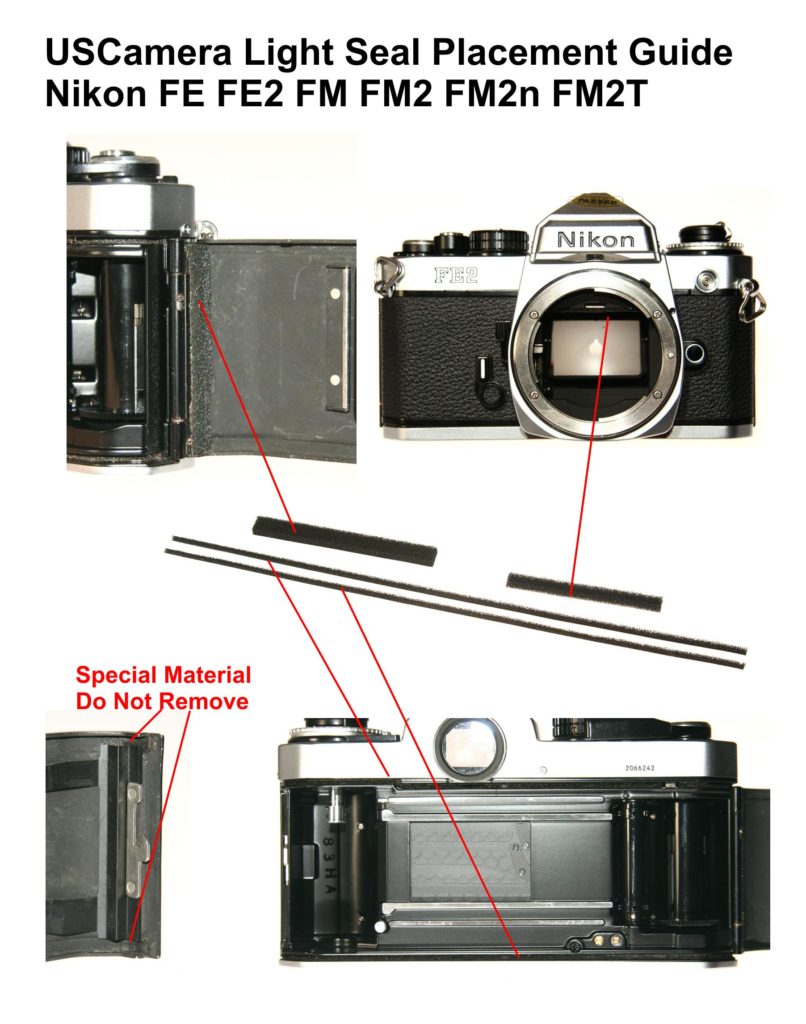Nikon FE FM Placement Guide
Before doing anything, please go here
Nikon FE FM Placement Guide
For more information on purchasing this kit, go here
This 4 piece light seal kit includes,
Top door channel seal on the camera body – 1 x 1mm
Bottom door channel seal on the camera body – 1 x 1mm
mirror cushion – 1 x 2mm
door hinge seal on the back cover – 1 x 2mm

The most important and time consuming work is removing the old seals. Focus on clean, clean, clean. Clean the old residue from the door channels, mirror cushion area, door hinge area and anywhere else you are replacing the seals. The finest adhesive in the world will not adhere to that sticky, gooey residue that was once a quality light seal. Proper installation will give you thousands of light tight exposures.
USCamera Since 1998 | Pro Light Seal Installation Available | Light Seal Kits | Vintage Film Cameras
Lastly, always made to inspire…see New film camera products.







Thank you for a great seal kit and instruction , but now i have a small problem ! on door that gooey stuff is
gone on my old Nikon FE so what should i use to replace that gooey stuff ?
Regards
Kjell.
You will need to extra carefully clean the cover and remove the goo and material. I say extra carefully because you want keep the flat black finish as true to new as possible. Sometimes you can clean the material removed carefully with Acetone and re-use it. If not, you can use shutter curtain tapes as a replacement. Pliobond is a good adhesive to retain whatever you apply there. Gray
Hi Gray, here is Aitor from Spain. First of all I want to thank you for keeping such a nice webpage alive. All the information is really accessible, which is not always the case for analog cameras.
I have a Nikon FE that is giving me nightmares with light leaks. I notices that the seal in the door hinge was the most damaged, so I decided to do a DIY fix using double sided tape and a mouse pad. As I was fixing that, I also noticed that there were other 2 pieces of sealing material in the lock mechanism side, the ones that you warn “SPECIAL MATERIAL, DO NOT REMOVE”. Well, back then I didn’t know that, and as I saw it was a bit compressed, I decided to apply the same fix. Is it something I should worry about? Amd if so, is there any way of fixing it?
Thank you in advance 🙂
Aitor
Hello, Thanks for contacting me.
First, the hinge seal should be replaced with an open-cell foam seal. The mouse pad material will not compress properly. Very likely will stress the hinge or door.
What do I mean by that? The door or hinge could be deformed and when a proper seal was used at a later time, the camera may not be light-tight.
The pads at the latch end are very thin. Doubtful you could cut a thin enough piece of the “mouse pad” plus that material has too much friction and will more than likely just rub off or bunch up as the door closes.
I hope that helps you.
More information on those pads is listed here https://uscamera.com/film-camera-back-covers/
Is the mirror foam open or closed cell. I think the original was closed cell.
Thanks
Open cell foam is what Nikon used. Most was non-adhesive foam except for the door hinge seals. You do not want to use closed cell foam in your Nikon.
So I should use 2mm thick foam on the hinge
We make the light seal kits from pre-cut pieces in stock. The dimensions are not listed, only part numbers required for the kits we assemble. Sorry I cannot be of more help.